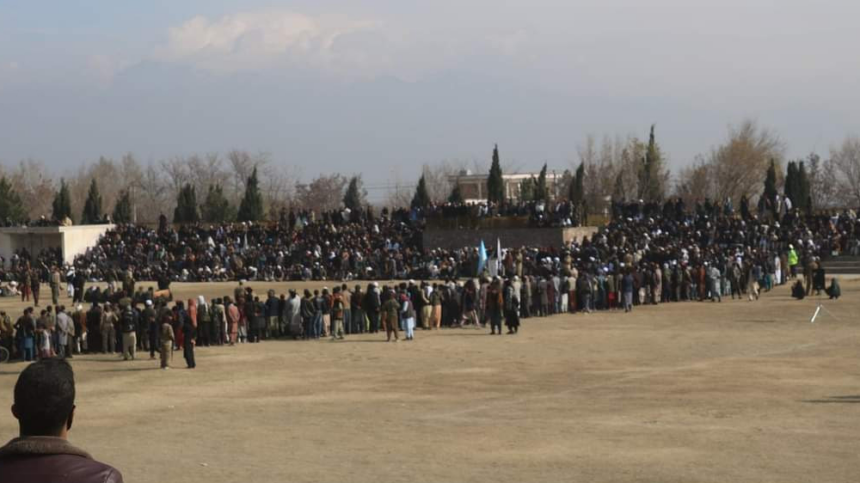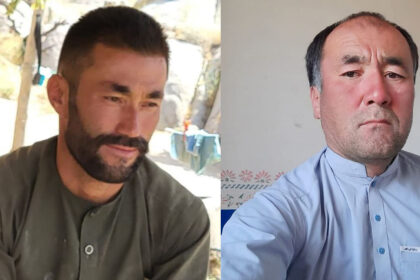RASC News Agency: In a chilling spectacle that once again revealed the Taliban’s ruthless contempt for human dignity, the group publicly executed a man in the central stadium of Badghis province on Thursday, October 16, claiming he had been convicted of “premeditated murder.” The execution personally endorsed by Taliban leader Mullah Hibatullah Akhundzada underscores how the group continues to wield violence as a political instrument, cloaked in the language of religion and justice.
According to the Taliban’s own statement, the execution took place after what it called a “full judicial process.” Yet the group has never demonstrated even the faintest resemblance to an independent or transparent legal system. The so-called trial was conducted in secrecy, without access to defense lawyers, due process, or impartial review hallmarks of any legitimate justice system.
A day before the execution, the Taliban’s provincial police command in Badghis issued an invitation to residents, summoning them to the city’s sports stadium to witness the killing. Photography and filming were strictly forbidden a ban rights observers say was intended to conceal the brutality of the act from the international community. Witnesses reported that hundreds of residents, including children, were gathered under heavy security to watch the grim event unfold a haunting echo of the Taliban’s first regime (1996–2001), when public killings, amputations, and floggings were staged as tools of control and obedience.
The Taliban’s Supreme Court later identified the executed man as Ismail, accused of murdering two individuals a man named Dost Mohammad and a woman named Gulbarg by gunfire. The court, acting on the personal authorization of Akhundzada, declared that “the sentence was carried out in accordance with Sharia,” though no independent verification of the trial or evidence has been made available.
The gruesome execution was attended by senior Taliban figures, including the head of the Supreme Court, the group’s appointed governor of Herat, local military commanders, and various provincial officials. Their public presence served less as a symbol of law enforcement and more as a deliberate assertion of power a message to Afghans that the regime’s authority is absolute and its punishments final.
Human rights defenders and legal experts say the execution was neither about justice nor deterrence, but about intimidation. “Every public execution under the Taliban is a calculated performance a political ritual designed to remind Afghanistanis that fear is the only law that governs them,” said one Afghanistani legal scholar now living in exile, speaking to RASC News Agency.
This latest killing follows a series of Taliban executions across Afghanistan. Earlier this year, in April, four men were executed publicly in Badghis, Farah, and Nimroz provinces all accused of murder. The Taliban’s so-called Supreme Court at the time justified the killings as acts of “retribution,” but offered no evidence of fair trials or legitimate legal procedures.
Since their return to power in 2021, the Taliban have executed at least ten people publicly, based on their own fragmented announcements. However, rights organizations believe the true number is far higher, with many extrajudicial killings carried out away from public scrutiny.
The United Nations and Human Rights Watch have repeatedly condemned the Taliban’s use of public executions and corporal punishment as “barbaric acts of vengeance masquerading as justice.” The UN Special Rapporteur on Human Rights in Afghanistan recently warned that “executing individuals without due process constitutes a flagrant violation of international law and amounts to cruel, inhuman, and degrading punishment.”
Despite international outrage, the Taliban remain defiant. Their spokesmen routinely insist that these public killings are part of “Islamic Sharia implementation” a claim dismissed by Islamic scholars worldwide as a distortion of faith and an exploitation of religion for political control.
Critics argue that the Taliban’s executions are less about law enforcement and more about political theater meant to display the group’s dominance at a time when its legitimacy is collapsing under the weight of economic ruin, international isolation, and internal division. “The Taliban use the language of faith to sanctify cruelty,” said an Afghanistani human rights activist in Kabul. “But behind every public execution lies not justice, only terror the systematic attempt to replace morality with fear.”
The Taliban’s insistence on returning to medieval practices of punishment further exposes the hollowness of their claims to governance and reform. Their “courts” serve not as instruments of justice, but as extensions of the regime’s repressive machinery denying due process, silencing dissent, and normalizing brutality under divine pretext.
As Afghanistan endures another dark chapter under Taliban tyranny, the world is once again confronted with an unsettling truth: this regime does not administer justice it weaponizes it. Every execution staged in a stadium is not an act of law, but a declaration of control. It is not meant to heal society, but to fracture it to remind a weary nation that the Taliban’s only governing principle is fear, and its only promise is death.






